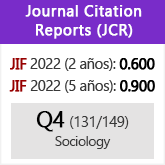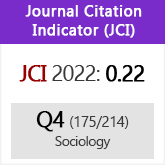El panel de loterías como tarea no paramétrica para la obtención de la actitud frente al riesgo
DOI:
https://doi.org/10.3989/ris.2011.07.1APalabras clave:
Aversión al riesgo, Loterías, Tests psicométricos, Toma de decisionesResumen
En este trabajo proponemos una tarea sencilla que permite obtener la actitud frente a la toma de riesgo monetario, y que llamaremos tarea Sabater-Grande y Georgantzís (SGG) de riesgo. Esta tarea consiste en una serie de loterías construidas para compensar las opciones de mayor riesgo con un mayor retorno. Utilizando la técnica de componentes principales, encontramos que la tarea SGG es capaz de capturar dos dimensiones de la toma de decisiones individuales: por un lado, la voluntad promedio de los sujetos de elegir proyectos arriesgados y, por otro, su sensibilidad hacia las variaciones en el retorno por riesgo. Presentamos los resultados de una gran muestra de datos obtenidos a partir de la implementación de la tarea SGG, y discutimos las regularidades y la conveniencia de su bidimensionalidad tanto para describir el comportamiento en condiciones de incertidumbre como para explicar el comportamiento humano en otros contextos.
Descargas
Citas
Abdellaoui, M. 2000. “Parameter-free elicitation of utility & probability weighting functions.” Management Science 46:1497-1512. http://dx.doi.org/10.1287/mnsc.46.11.1497.12080
Abdellaoui, M., Bleichrodt, H. and C. Paraschiv. 2007. “Loss aversion under prospect theory: A parameter-free measurement.” Management Science 53:1659-1674. http://dx.doi.org/10.1287/mnsc.1070.0711
Allais, M. 1953. “Le comportement de l’homme rationnel devant le risque: critique des postulats et axiomes de l’école Américaine.” Econometrica 21: 503-546. http://dx.doi.org/10.2307/1907921
Andersen, S., Harrison, G., Lau, M. and E. Rutström. 2008. “Eliciting risk and time preferences.” Econometrica 76:583-618. http://dx.doi.org/10.1111/j.1468-0262.2008.00848.x
Bechara, A., Damasio. A. R., Damasio, H. and S.W Anderson. 1994. “Insensitivity to future consequences following damage to human prefrontal cortex.” Cognition 50:7-15. http://dx.doi.org/10.1016/0010-0277(94)90018-3
Berns, G. S., Capra, M., Chappelow, J., Moore, S. and C. Noussair. 2008. “Nonlinear neurobiological probability weighting functions for aversive outcomes.” Neuroimage 15:2047-2057. http://dx.doi.org/10.1016/j.neuroimage.2007.10.028 PMid:18060809 PMCid:2270401
Birnbaum, M. H. and J. Navarrete.1998. “Testing descriptive utility theories: Violations of stochastic dominance and cumulative independence.” Journal of Risk and Uncertainty 17:49-78. http://dx.doi.org/10.1023/A:1007739200913
Bosch-Domènech, A. and J. Silvestre. 2006. “Risk aversion and embedding bias.” Economics Working Papers No. 934. Department of Economics and Business, Universitat Pompeu Fabra. Spain.
Brañas-Garza, P., Georgantzís, N. and P. Guillén. 2007. “Direct and indirect effects of pathological gambling on risk attitudes.” Judgment and Decision Making 2(2):126-136.
Brañas-Garza, P., Guillén, P. and R. López del Paso. 2008. “Math skills and risk attitudes.” Economics Letters 99:332-336. http://dx.doi.org/10.1016/j.econlet.2007.08.008
Camerer, C. 1989. “An experimental test of several generalized utility theories.” Journal of Risk and Uncertainty 2(1):61-104. http://dx.doi.org/10.1007/BF00055711
Camerer, C. and T. Ho. 1994. “Violations of betweenness axiom and nonlinearity in probability.” Journal of Risk and Uncertainty 8:167-196. http://dx.doi.org/10.1007/BF01065371
Campo, S., Guerre, E., Perrigne, I. and Q. Vuong. 2002. “Semiparametric estimation of first-price auctions with risk averse bidders.” Working Paper, University of Southern California.
Carbone, E. and J. Hey. 2000. “Which error story is best?” Journal of Risk and Uncertainty 20:161-176. http://dx.doi.org/10.1023/A:1007829024107
Cox, J. C. and R. L. Oaxaca. 1996. “Is Bidding behavior consistent with bidding theory for private value auctions.” Pp. 131-148 in Research in Experimental Economics, vol. 6, edited by R.M. Isaac. Greenwich, Conn.: JAI Press.
García-Gallego, A., Georgantzís, N., Pereira, P. and J.C. Pernías-Cerrillo. 2005. “Competing against simulated equilibrium price dispersions: An experiment on Internet-assisted search markets.” Working Paper #5-12, NET Institute.
García-Gallego, A., Georgantzís, N., Navarro-Martínez, D. and G. Sabater-Grande. 2011. “The stochastic component in choice and regression to the mean.” Theory and Decision 71:251-267. http://dx.doi.org/10.1007/s11238-010-9223-6
García-Gallego, A., Georgantzís, N., Jaramillo-Gutiérrez, A. and M. Parravano. 2010. “The SGG risk elicitation task: Implementation and results.” The Papers 10/04, University de Granada. Spain.
Georgantzís, N., Genius, M., García-Gallego, A. and G. Sabater-Grande. 2003. “Testing for risk return individual decision making.” Working Paper 43/03. LINEEX, University of Valencia. Spain.
Goeree, J. K., Holt, C. A. and T. Palfrey. 2002. “Quantal response equilibrium and overbidding in privatevalue auctions.” Journal of Economic Theory 104(1):247-272. http://dx.doi.org/10.1006/jeth.2001.2914
Goeree, J., Holt, C. and T. Palfrey. 2003. “Risk averse behavior in generalized matching pennigames.” Games and Economic Behavior 45:97-113. http://dx.doi.org/10.1016/S0899-8256(03)00052-6
Goldstein, W. and H. Einhorn. 1987. “Expression theory and the preference reversal phenomena.” Psychological Review 94:236-254. http://dx.doi.org/10.1037/0033-295X.94.2.236
Harrison, G., List, J. and C. Towe. 2007. “Naturally occurring preferences and exogenous laboratory experiments: A case study of risk aversion.” Econometrica 75:433-458. http://dx.doi.org/10.1111/j.1468-0262.2006.00753.x
Harrison, G. W. and E. Rutström. 2009. “Expected utility theory and prospect theory: One wedding and a decent funeral.” Experimental Economics 12(2):133-158. http://dx.doi.org/10.1007/s10683-008-9203-7
Hey, J. and C. Orme. 1994. “Investigating generalizations of expected utility theory using experimental data.” Econometrica 62:1391-1426. http://dx.doi.org/10.2307/2951750
Holt, C. A. and S. K. Laury. 2002. “Risk aversion and incentive effects.” American Economic Review 92(5):1644-1655. http://dx.doi.org/10.1257/000282802762024700
Hsu, M., Krajbich, I., Zhao, C. and C. F. Camerer. 2009. “Neural response to reward anticipation under risk is nonlinear in probabilities.” Journal of Neuroscience 29:2231-2237. http://dx.doi.org/10.1523/JNEUROSCI.5296-08.2009 PMid:19228976
Kanheman, D. and A. Tversky. 1979. “Prospect theory: An analysis of decision under risk.” Econometrica 47(2):263-292. http://dx.doi.org/10.2307/1914185
Lusk, J. and K. Coble. 2005. “Risk perceptions, risk preference, and acceptance of risky food.” American Journal of Agricultural Economics 87:393-405. http://dx.doi.org/10.1111/j.1467-8276.2005.00730.x
Von Neumann and O. Morgenstern, 1944. Theory of Games and Economic Behavior. Princeton University Press.
Prelec, D. 1998. “The probability weighting function.” Econometrica 66:497-528. http://dx.doi.org/10.2307/2998573
Rabin, M. and R. H. Thaler. 2001. “Anomalies: Risk aversion.” Journal of Economic Perspectives 15(1): 219-232. http://dx.doi.org/10.1257/jep.15.1.219
Raven, J. C. 1976. Advanced Progressive Matrices. Sets I and II. Oxford: Psychologists Press.
Rigas, G., Carling, E. and B. Brehmer. 2002. “Reliability and validity of performance measures in microworlds.” Intelligence 50(5):463-480. http://dx.doi.org/10.1016/S0160-2896(02)00121-6
Sabater-Grande, G. and N. Georgantzís. 2002. “Accounting for risk aversion in repeated prisoners’ dilemma games: An experimental test.” Journal of Economic Behavior and Organization 48:37-50. http://dx.doi.org/10.1016/S0167-2681(01)00223-2
Stott, H. 2006. “Cumulative prospect theory’s functional menagerie.” Journal of Risk and Uncertainty 32:101-130. http://dx.doi.org/10.1007/s11166-006-8289-6
Tversky, A. and D. Kahneman. 1992. “Advances in prospect theory: Cumulative representation of uncertainty.” Journal of Risk and Uncertainty 5:297-323. http://dx.doi.org/10.1007/BF00122574
Wakker, P. and D. Deneffe. 1996. “Eliciting von Neumann-Morgenstern utilities when probabilities are distorted or unknown.” Management Science 42(8):1131-1150. http://dx.doi.org/10.1287/mnsc.42.8.1131
Wang, M., Rieger, M. O. and T. Hens. 2010. “How time preferences differ: Evidence from 45 countries.” Research Paper No. 09-47. Swiss Finance Institute.
Weber, E. U. and C. K. Hsee, C. K. 1998. “Cultural differences in risk perception, but cross-cultural similarities in attitudes towards perceived risk.” Management Science 44(9):1205-1217. http://dx.doi.org/10.1287/mnsc.44.9.1205
Weber, E.U. and C. K. Hsee. 1999. “Models and mosaics: Investigating cross-cultural differences in risk perception and risk preference.” Psychonomic Bulletin & Review 6(4): 611-617. http://dx.doi.org/10.3758/BF03212969
Zukerman, M. 1979. Sensation Seeking: Beyond the Optimal Level of Arousal. New York: Erlbaum Associates.
Descargas
Publicado
Cómo citar
Número
Sección
Licencia
Derechos de autor 2012 Consejo Superior de Investigaciones Científicas (CSIC)

Esta obra está bajo una licencia internacional Creative Commons Atribución 4.0.
© CSIC. Los originales publicados en las ediciones impresa y electrónica de esta Revista son propiedad del Consejo Superior de Investigaciones Científicas, siendo necesario citar la procedencia en cualquier reproducción parcial o total.Salvo indicación contraria, todos los contenidos de la edición electrónica se distribuyen bajo una licencia de uso y distribución “Creative Commons Reconocimiento 4.0 Internacional ” (CC BY 4.0). Puede consultar desde aquí la versión informativa y el texto legal de la licencia. Esta circunstancia ha de hacerse constar expresamente de esta forma cuando sea necesario.
No se autoriza el depósito en repositorios, páginas web personales o similares de cualquier otra versión distinta a la publicada por el editor.

















